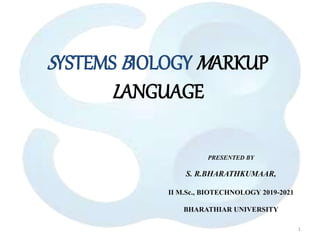
SYSTEMS BIOLOGY MARKUP LANGUAGE.pptx
- 1. SYSTEMS BIOLOGY MARKUP LANGUAGE 1 PRESENTED BY S. R.BHARATHKUMAAR, II M.Sc., BIOTECHNOLOGY 2019-2021 BHARATHIAR UNIVERSITY
- 2. SYSTEMS BIOLOGY MARKUP LANGUAGE (SBML) SBML is a machine-readable language, based on XML, free and open interchange format for representing models of biological processes. It can represent metabolic networks, cell-signaling pathways, regulatory networks and many other kinds of systems. SBML as an input and output format, different software tools can operate on the same representation of a model, removing chances for errors in translation and assuring a common starting point for analyses and simulations SBML can encode models consisting of entities (for example, molecular species) linked and modified by processes (for example, biochemical reactions). Here is an artificial example of a small set of biochemical reactions The symbols in square brackets (e.g., S1) represent concentrations of molecular species, the arrows represent reactions, and the formulas above the arrows represent the rates at which the reactions take place. Broken down into its constituents, this model contains a number of components: reactant species, product species, reactions, reaction rates, and parameters in the rate expressions. 2
- 3. Two important principles in SBML are that Models are decomposed into explicitly-labeled constituent elements, and The representation deliberately does not cast the model directly into a set of differential equations or other specific interpretation of the model. This makes it easier for a software tool to interpret the model and translate the SBML form into whatever internal form the tool actually uses How is SBML is used? • Meant to provide an exchange language for software tools • Don’t write SBML by hand, a software can do it • Software tools that “speak” SBML provides a higher-level interface • Applications usually have their own native format. • Import/export SBML rather than natively save as SBML. Some important SBML constructs Basic elements Species Compartment Parameter Reaction 3 Additional useful elements Unit definition Rule Function definition Event Initial assignment Constraint
- 4. SBML “rules” Rules in SBML define extra mathematical expressions E.g., If need to express additional mathematical relationships beyond what is implied by the system of reactions. 3 subtypes: Rules that defines relationship that hold at all times 4 Rules in the context of the overall model Equation derived from reaction definitions Algebraic rules Assignment rules Rate rules
- 5. 5
- 6. 6
- 7. 7
- 8. 8
- 9. 9
- 10. 10
- 11. 11
- 12. 12
- 13. 13
- 14. 14
- 15. 15
- 16. Some practical details useful to know about SBML 16
- 17. F 17
- 18. 18
Notes de l'éditeur
- (And while this example uses concentrations, it could equally have used other measures, such as the number of molecules of each chemical species.)
- Accepted by dozens of journals 100’s of software tools available today Libraries: libSBML, JSBML 260+ listed in SBML software guide 1000’s of model available In public databases eg., Bio-Models database, Reactome As supplementary data to papers In private repositories
- Level 3 packages add constructs on top of sbml level 3 core